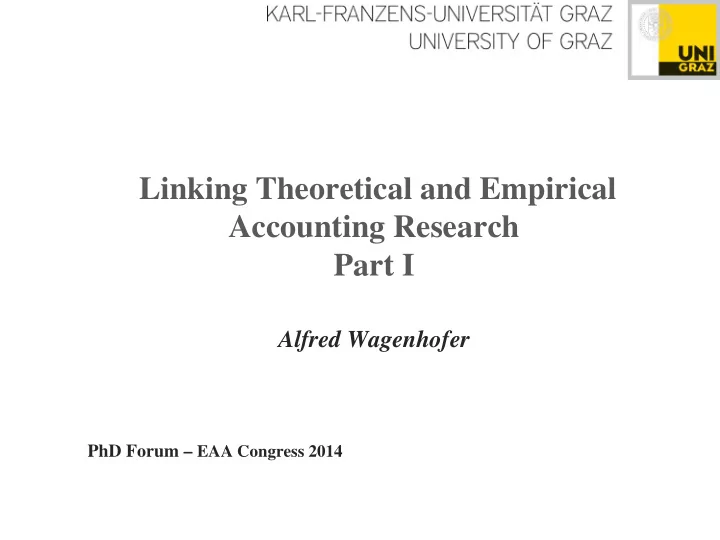

1 Linking Theoretical and Empirical Accounting Research Part I Alfred Wagenhofer PhD Forum – EAA Congress 2014 1
2 An example of interesting research Frick, Gürtler, and Prinz (zfbf 2008) Research question: Effort incentives in tournaments – Is it better to let homogenous or heterogeneous contestants compete? Prior research presumes that contestants with more homogenous capabilities exert more effort 1. This paper develops an economic model to derive effort predictions in a tournament 2. The paper tests the predictions with a unique data set 2
3 An example of interesting research Model Tournament with two players (or teams) Performance is stochastic and increases in ability and effort Each player decides on privately costly effort Player with higher actual performance wins Main result Optimal efforts of both players is strictly decreasing in the absolute difference in capabilities Intuition (i) Player with lower capability realizes that winning is unlikely optimally reduces effort (ii) Player with higher capability infers this reaction and optimally reduces effort as a best response to the lower effort of the other player 3
4 An example of interesting research Empirical test: German soccer league Players are the 18 teams Proxy for effort: Number of yellow cards Not red cards because based more on intolerable behavior Note: Scores are bad proxies for effort because can be positively associated with effort (high offensive effort) or negatively (low defense effort) Proxy for heterogeneity: Difference in betting odds Hypothesis: The lower the difference in betting odds the more yellow cards are shown to players Control variables: age (linear and squared) of referee, BMI of referee, goals, home game, number of viewers, local derby 4
5 An example of interesting research Dependent variable: Yellow cards Negative binomial model Coeff. t-value Constant 1,8366 1,09 Heterogeneity -6126 *** -4,46 Age of referee 0,0194 0,22 Age squared of referee -0,0003 -0,3 BMI referee 0,008 0,48 Goals of home team 0,0128 0,48 Goals of guest team -0,003 -0,19 Viewers -0,0032 -0,06 Viewers squared 0 0,83 Derby -0,0025 -0,02 Goal difference at break -0,0137 -0,52 McFadden_R 2 0,032 Wald c 2 22,18 *** n 756 Source: Frick, Gürtler, and Prinz (zfbf 2008) 5
6 Theory and empirics are inherently linked Theory Empirics Source: Libby, Bloomfeld, and Nelson (AOS 2002) 6
7 What makes a paper exciting? Contribution! Consider the following Paper states intuitively plausible hypothesis Tests this hypothesis and finds that the results are consistent with the hypothesis Question: What did we learn? What could we learn? Are there alternative explanations? Are there competing hypotheses? Can we identify situations in which intuitive hypotheses do not work? What about economic significance? This requires more emphasis on theory 7
8 Benefits of linking theory and empirics Intellectual stimulation Greater completeness of research: theory and test Credibility of both theory and empirics More persuasive contribution Less criticism that theory builds on unrealistic assumptions Assurance that hypotheses are not ad hoc, but derived from coherent and consistent theory Less criticism that ex post hypotheses are created to match the data or data fishing Triangulation Theory and empirics are complementary Deduction: Theory empirical tests Induction: Empirical regularity development of theory 8
9 Why few papers include theoretical and empirical research? Hard to build expertise in multiple methodologies Lack of education, high investment cost But one can team up with coauthors accordingly Evaluation process in top journals Mainstream research in accounting is single method – unlike other fields Papers become too long Have hard time with review process: requires reviewers that are experts in more methodologies Attention of some reviewers shift to validity of proxies (link of theory and data) But hard to defend as valid arguments Accounting research is likely to evolve 9
10 Methodologies Theoretical research Empirical research Sources: Economics, finance, Methods: Archival, experimental, organization, sociology, field, case, survey, … psychology, … Strengths: “Reality”, descriptive Strengths: Consistency, rigor, and external validity internal validity Weaknesses: M any possible Weaknesses: Narrow scope, influences at work, causality strong assumptions, hidden assumptions/beliefs Performance measure: Descriptive evidence, significance Performance measure: of relation, discrimination among New insights, counter-intuitive different theories results 10
11 Some challenges Theory Rests on priors about central economic forces of phenomenon Latent assumptions Results hard to generalize Does not say anything about competing theories Empirics Data availability Availability and selection of proxies in archival research Subjects for experiments and experimental design Access and confidentiality in case or field research Unobservable conditions, omitted variables, endogeneity 11
12 Example: Testing agency theory Pay for performance sensitivity Demski and Sappington (MAR 1999) Unobservability of effects Multiple outputs, but not all are unobservable – empirical association between observable output and pay sensitivity blurred Multi-period consequences Out-of-equilibrium strategies Agent induced to work hard – pay sensitivity depends on alternative actions that are not taken under optimal contract Threat points – other incentive mechanisms that are never played out (eg high sanctions deter particular behavior) Multiple equilibria – which ones are played in reality? 12
13 Example: Endogeneity Does better corporate governance improve firm performance? Many empirical studies Few take into account the endogeneity of corporate governance Ex ante no expectation of positive correlation between governance and performance Theory can explain positive correlation More profitable firms require more governance – causality reverses! Provides guidance for new tests Source: Hermalin (Handbook 2013) 13
14 Summary: Linking theory with empirics Theory and empirics are complementary Theoretical research Provides basis for predictions and to derive hypotheses – and competing hypotheses Necessary to get a hold on causality Helps to determine controls in empirical studies Empirical research Gives insights whether theory “works” Help to estimate economic significance of effect Can distinguish between alternative explanations Provides descriptive evidence to stimulate theory Ultimately, developing a theory and empirically testing it leads to more interesting and innovative research 14
Recommend
More recommend